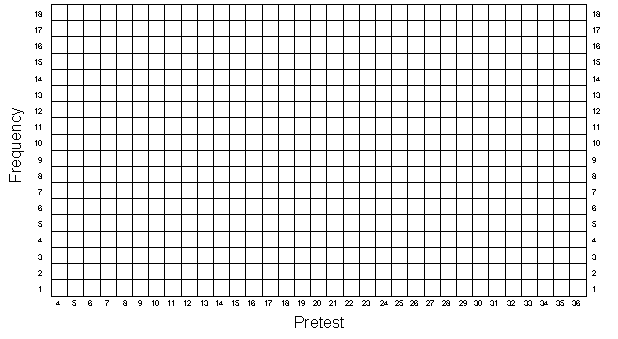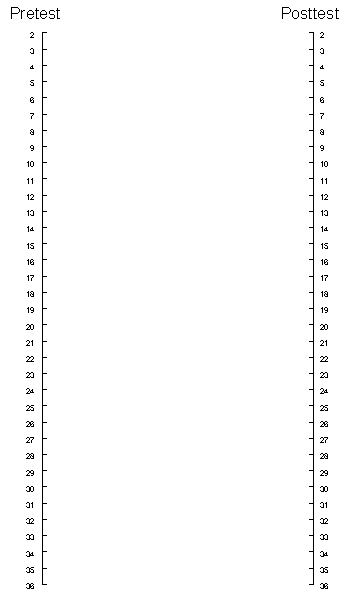


Matched Cases from Table 5-1


In this exercise we are going to look at the phenomenon of regression
artifacts or "regression to the mean." First, you will
use the data from the original simulation and create nonequivalent
groups just like you did in the Nonequivalent Group Design exercise.
Then you will "match" persons from the program
and comparison groups who have the same pretest scores, dropping
out all persons for whom there is no match. You do this because
you are concerned that the groups have different pretest averages,
and you would like to obtain "equivalent" groups.
Second, you are going to regraph the data for all 50 persons
from the Generating Data (GD) exercise, to gain a deeper understanding
of regression artifacts.
To begin, review what you did in the NEGD exercise. Starting
with 50 pretest and posttest scores (each composed of a common
true score and unique error components), you first made the groups
nonequivalent on the pretest by adding 5 to each program person's
pretest value. This initial difference was the same on the posttest,
and so you added the same 5 points there. Finally, you included
a program effect of 7 points, added to each program person's
posttest score.
In this exercise, you will start with the data in the GD exercise,
and will do the same thing you did in the NEGD exercise except
that we will not add in a program effect. That is, in this simulation
we assume that the program either was never given or did not work
(i.e., the null case). The first thing you need to do is to copy
the pretest scores from column 5 of Table 1-1 into column 2 of
Table 5-1. Now, you have to divide the 50 participants into two
nonequivalent groups. We can do this in several ways, but the
simplest would be to consider the first 25 persons as being in
the program group and the second 25 as being in the comparison
group. The pretest and posttest scores of these 50 participants
were formed from random rolls of pairs of dice. Be assured, that
on average these two subgroups should have very similar
pretest and posttest means. But in this exercise we want to assume
that the two groups are nonequivalent and so we will have to make
them nonequivalent. The easiest way to make the groups nonequivalent
on the pretest is to add some constant value to all the pretest
scores for persons in one of the groups. To see how you will
do this, look at Table 5-1. You should have already copied the
pretest scores (X) for each participant into column 2. Notice
that column 3 of Table 5-1 has a number "5" in it
for the first 25 participants and a "0" for the second
set of 25 persons. These numbers describe the initial pretest
differences between these groups (i.e., the groups are nonequivalent
on the pretest). To create the pretest scores for this exercise,
add the pretest scores from column 2 to the constant values in
column 3 and place the results in column 4 of Table 5-1 under
the heading "Pretest (X) for Regression Artifacts".
Note that the choice of a difference of 5 points between the
groups was arbitrary. Also note that in this simulation we have
let the program group have the pretest advantage of 5 points.
Now you need to create posttest scores. You should copy the posttest
scores from column 6 of Table 1-1 directly into column 5 of Table
5-1. In this simulation, we will assume that the program either
has no effect or was never given, and so you will not add any
points to the posttest score for the effect of the program. But
we assume that the initial difference between the groups persists
over time, and so you will add to the posttest the 5 points
that describes the nonequivalence between groups. In Table 5-1,
the initial group difference (i.e., 5 points difference) is listed
again in column 6. Therefore, you get the final posttest score
by adding the posttest score in column 5 and the group differences
in column 6. The sum should be placed in column 7 of Table 5-1
labeled "Posttest Y for Regression Artifacts".
Now, just as you have done in previous exercises, plot the pretest
and posttest frequency distributions in Figures 5-1 and 5-2, being
sure to use different colors for the program (persons 1-25) and
comparison (persons 26-50) groups. Also, estimate the central
tendency for each group on both the pretest and posttest. You
should notice that the average of the program groups is about
5 points higher than the average of the comparison group on both
measures.
If you were conducting a nonequivalent group design quasi-experiment
and obtained the pretest distribution in Figure 5-1, you would
rightly be concerned that the two groups differ prior to getting
the program. To remedy this, you might think it is a good idea
to look for persons in both groups who have similar pretest scores,
and use only these matched cases as the program and comparison
groups. You might conclude that by only using persons "matched"
on the pretest you can obtain "equivalent" groups.
You will match persons on their pretest scores, and put the matched
cases in Table 5-2. To do this, first look at the pretest frequency
distribution in Figure 5-1. Notice again that the comparison
group tended to score lower. Beginning at the lowest pretest
score and moving upwards, find the lowest pretest score at which
there are both program and comparison persons. Most likely there
will be more comparison persons than program ones at the first
score that has both. For instance, let's imagine that the pretest
score of 9 is the first score that has persons from both groups
and that at this value there are two cases from the comparison
group and one from the program group. Obviously you will only
be able to find one matched pair--you will have to throw out the
data from one of the comparison group person because there is
only a single program group case available for matching. Since
the dice used to generate the data yield random scores, you can
simply take the first person in the comparison group (Table 5-1,
persons 26-50) who scored a 9 on the pretest. Record that person's
ID number in column 1 of Table 5-2, their pretest in column 2
and their posttest score in column 3. Next, find the program
person (in Table 5-1, persons 1-25) who also scored a 9 on the
pretest and enter that person's ID number in column 4 of
Table 5-2, their pretest in column 5 and their posttest score
in column 6. Then move to the next highest pretest score in Figure
5-1 for which there are persons from both groups. Again, find
matched pairs, and enter them into Table 5-2. Continue doing
this until you have obtained all possible matched pairs. Notice
that you should never use the same person more than once in Table
5-2.
At this point, you have created two groups matched on the pretest.
To do so, you had to eliminate persons from the original sample
of 50 for whom no pretest matches were available. You may now
be convinced that you have indeed created "equivalent"
groups. To confirm this, you might calculate the pretest averages
of the program and comparison groups. They should be identical.
Have you in fact, created "equivalent" groups? Have
you removed the selection bias (of 5 points) by matching on the
pretest? Remember that you have not added in a program effect
in this exercise. If you successfully removed the selection difference
on the pretest by matching, you should find no difference between
the two groups on the posttest (because you only put in the selection
difference between the two groups on the posttest). Calculate
the posttest averages for the program and comparison groups in
Table 5-2. What do you find?
Most of you will find that on the posttest the program group scored
higher on average than the comparison group did. If you were
conducting this study, you might conclude that although the matched
groups start out with equal pretest averages, they differ on the
posttest. In fact, you would be tempted to conclude that the
program is successful because the program group scored higher
than the comparison group on the posttest. But something is obviously
wrong here--you never put in a program effect! Therefore, the
posttest difference that you are finding must be wrong.
To discover what is wrong you will plot the data in Table 5-2
in a new way. Look at Figure 5-4 labeled "Pair-Link Diagram".
Starting with only the comparison persons in Table 5-2, draw
a straight line between the pretest and posttest scores of each
person. Do the lines tend to go up, down, or stay the same from
pretest to posttest? Next, using a different colored pen, draw
the lines for the program group persons in Table 5-2. In which
direction do these lines go? You should find that most of the
program group lines go down while most of the comparison group
lines go up from pretest to posttest. As a result of what you
have seen, you should be convinced of the following:
Why do regression artifacts occur? We can get some idea by looking
at a pair-link diagram for the entire set of 50 persons in the
original Generating Data exercise. Draw the pair-links for each
of the 50 persons of Table 1-1 on Figure 5-5. Recall that for
this original set of data we had only one group (i.e., no program
and comparison group), no selection biases and no program effects.
You should be convinced of the following:




